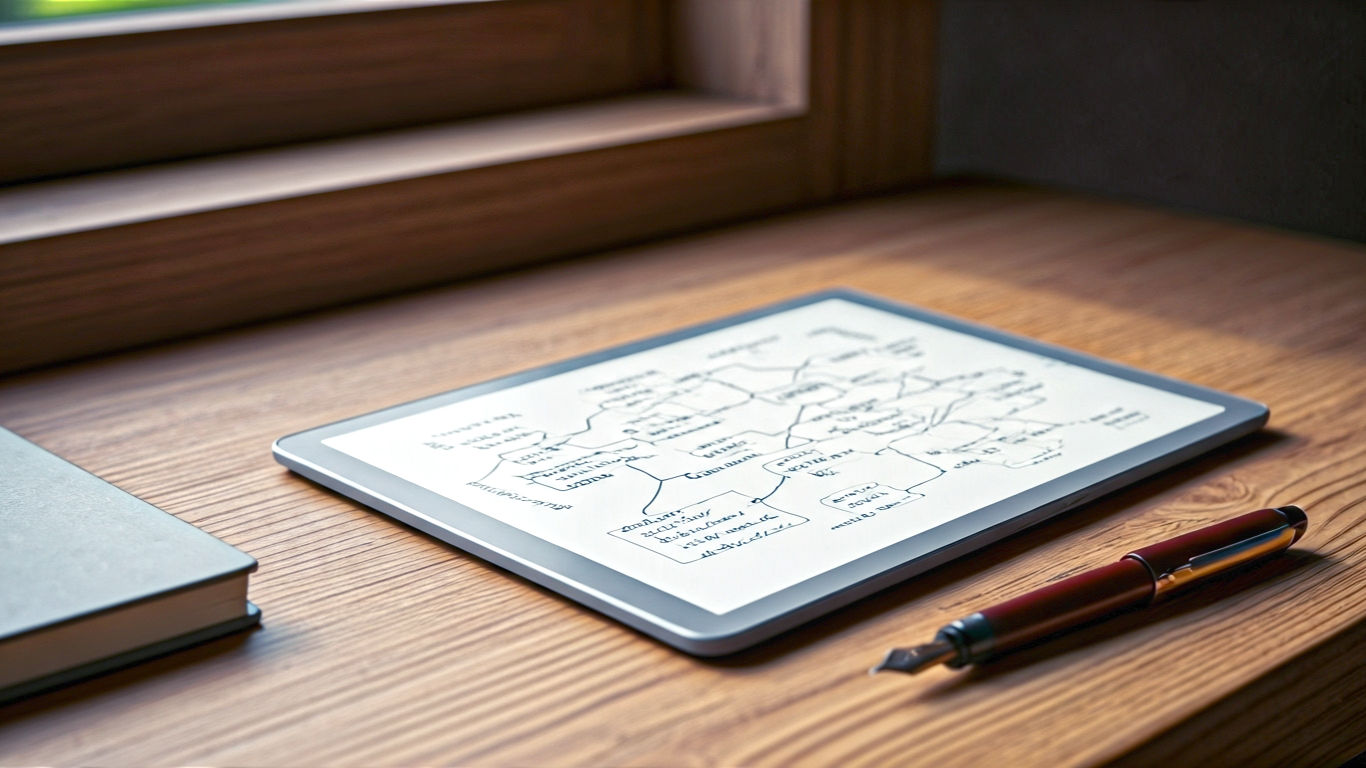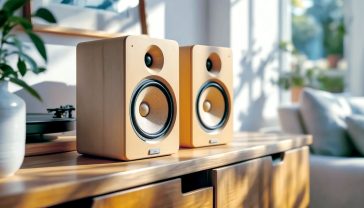The Guide to the BOOX Go 10.3: The Paper-Like Tablet Shaking Up the UK Market
An in-depth review of the BOOX Go 10.3 e-paper tablet. We explore its design, screen, and Android software, and compare it to the reMarkable 2.

This post may contain affiliate links. If you make a purchase through these links, we may earn a commission at no additional cost to you.
In a world buzzing with notifications, glaring screens, and the constant hum of digital distraction, the idea of a quiet, focused device feels less like a retro novelty and more like an essential tool for sanity. We’re all familiar with the eye-strain from a long day staring at a laptop, or the rabbit hole of social media you fall into when you just wanted to check one email on your iPad. Enter the e-paper tablet, a category of gadgets designed to bring the calm, tactile experience of paper into the digital age.
For years, this space has been dominated by a few key players, most notably the minimalist and rather brilliant reMarkable 2. But now, a new contender has arrived, and it’s making some serious waves. The BOOX Go 10.3 is a wafer-thin, impossibly light e-paper tablet that doesn’t just want to replace your notebook; it wants to be your all-in-one reading, writing, and thinking companion. It promises the zen-like focus of an e-ink screen but with the surprising versatility of an Android operating system.
-
Features a 10.3-inch HD Carta 1200 glass screen with a flat cover-lens and a resolution of 2480×1860 (300 ppi).
-
Supports both capacitive touch and BOOX stylus touch with 4,096 levels of pressure sensitivity.
-
Powered by a 2.4Ghz Octa-core processor, with 4GB of RAM and 64GB of internal storage.
-
Includes dual-band Wi-Fi (2.4GHz + 5GHz) and Bluetooth 5.0 for connectivity.
-
Equipped with a G-sensor for automatic screen rotation.
-
Please note: This device does not have a front light.
But is it any good? Does it live up to the hype, and could it really be the device that helps you reclaim your focus, whether you’re a student revising for A-Levels in a noisy Costa, a professional sketching out ideas between meetings in Canary Wharf, or simply someone who loves the feel of a good pen on paper? In this definitive review, we’ll dive deep into everything the BOOX Go 10.3 has to offer, from its stunning design to its controversial lack of a front light. We’ll explore what it’s like to use day-to-day, pit it against its biggest rival, and ultimately help you decide if this is the digital notebook you’ve been waiting for.
What on Earth is an E-Paper Tablet, Anyway?
Before we get into the nuts and bolts of the Go 10.3, it’s worth taking a moment to understand what we’re actually talking about. If you’ve ever used an Amazon Kindle, you’re already halfway there.
A Simple Explanation: Digital Ink
Imagine a screen made up of millions of tiny microcapsules, each no wider than a human hair. Inside each capsule are black and white particles, all floating in a clear fluid. The black particles are negatively charged, and the white ones are positively charged.
When you apply a negative electric field to the bottom of the screen, it pushes the negative black particles to the top, and you see a black dot. Apply a positive field, and the positive white particles pop up instead. By controlling these fields across millions of capsules, the device can form crisp, clear text and images.
It’s like a high-tech Etch A Sketch.
Why It’s Different (and Better for Your Eyes)
This technology, known as E Ink, is fundamentally different from the LCD or OLED screens on your phone, TV, or laptop. Those screens are emissive – they generate their own light, which they shine directly into your eyeballs. This is what causes screen glare in bright sunlight and can lead to digital eye strain and disrupt sleep patterns, thanks to the blue light they pump out.
An e-paper display, on the other hand, is reflective. It doesn’t produce any light of its own. Instead, it reflects the ambient light in the room, just like a page in a book. This has three huge advantages:
- It’s incredibly easy on the eyes. Reading on an e-paper screen feels almost identical to reading on real paper. There’s no flicker, no backlight, and minimal blue light, allowing you to read or work for hours without discomfort.
- It’s brilliant in bright sunlight. Where your phone screen becomes a useless, reflective mess at the park or on the beach, an e-paper display just gets clearer and easier to read.
- The battery lasts for ages. Because the screen only uses power when the image is changing (i.e., when you turn a page or write a new word), the battery can last for weeks, not hours.
For years, this tech was mostly confined to e-readers like the Kindle. But now, devices like the BOOX Go 10.3 are taking that same beautiful, paper-like screen and giving it the power to do so much more.
First Impressions: Is This the Thinnest Gadget Ever Made?
Unboxing the BOOX Go 10.3 is a genuinely surprising experience. The first thing that hits you is just how impossibly thin and light it is. At 4.8mm thick and weighing a mere 375g, it feels less like a tablet and more like a slim portfolio folder. It’s lighter than its main rival, the reMarkable 2, and significantly more portable than a Kindle Scribe or an iPad.
This isn’t just a gimmick; it makes a real difference in daily use. You can hold it in one hand for hours without fatigue, and it disappears into a backpack or tote bag. For anyone commuting on the Tube or a busy train, this feather-light portability is a massive win.
Design and Build Quality
The design is a masterclass in modern minimalism. The front is dominated by the 10.3-inch screen, with slim, flush bezels. There’s a slightly wider ‘chin’ at the bottom and a wider bezel on the left-hand side, which provides a natural and comfortable place to grip the device without accidentally touching the screen. This asymmetric design is clever, catering to both left- and right-handed users, as a built-in G-sensor automatically rotates the screen to match your orientation.
The chassis is made from a sturdy aluminium-magnesium alloy, giving it a premium, rigid feel despite its thinness. It doesn’t feel fragile or like it might bend. The back has a textured, grey, vegan-leather finish that provides excellent grip and does a great job of repelling fingerprints – a small but welcome detail.
There are almost no buttons to speak of. A single power button sits on the top edge, and that’s it. On the bottom, you’ll find a USB-C port for charging and data transfer, flanked by two surprisingly decent speaker grilles. There’s no headphone jack, but you can connect Bluetooth headphones for listening to audiobooks or music.
Overall, the build quality is outstanding. It feels like a premium, well-engineered piece of kit that punches well above its price point. It’s elegant, practical, and a genuine pleasure to hold.
The Screen: A Tale of Two Halves
The display is the star of the show, but it’s also the device’s most polarising feature. It’s a 10.3-inch E Ink Carta 1200 screen, which is the latest and greatest in monochrome e-paper technology. It boasts a resolution of 2480×1860, which works out to a fantastically sharp 300 pixels per inch (ppi).
For context, that’s the same sharpness as a high-end Kindle and significantly crisper than the 226 ppi screen on the reMarkable 2. The result is that text is incredibly clean and clear, almost indistinguishable from a printed page. Whether you’re reading a dense PDF report or a novel, the clarity is superb.
However, there’s a massive catch, and it’s right there in the product description: there is no front light.
Living Without a Light: Brave or Bonkers?
This is a deliberate design choice by BOOX, likely to achieve that incredible thinness and to keep the cost down. It’s a choice that firmly places the Go 10.3 in the same camp as the reMarkable 2 and sets it apart from devices like the Kindle Scribe.
What does it mean in practice? It means you use the Go 10.3 exactly as you would a piece of paper. In a well-lit room, on the train during the day, or sitting outside, it’s absolutely fantastic. But in a dimly lit living room in the evening, or trying to read in bed without disturbing your partner, you’re out of luck. You’ll need a lamp, just as you would with a paperback.
For some, this is a deal-breaker. If your primary use case is reading in bed, this isn’t the device for you. However, for others, it’s a non-issue and even a benefit. The lack of any light source makes it the ultimate distraction-free, eye-friendly device. It forces you into a more mindful, paper-like way of working. It’s a bold move, and whether it’s a pro or a con depends entirely on how and where you plan to use it.
Some users have also noted the screen background is a little darker or greyer compared to a Kindle Paperwhite or even the reMarkable 2. The contrast between the grey background and the black ink is still excellent, but it’s not quite the bright, paper-white look some might be expecting.
The Writing Experience: A Digital Dream
This is where the BOOX Go 10.3 truly shines. For digital note-taking, it’s nothing short of sensational. The screen has a slightly textured surface that, when combined with the included BOOX Pen Plus stylus, provides a wonderfully tactile and satisfying writing experience. It has just the right amount of friction to feel remarkably like writing on a high-quality paper notepad.
The stylus itself is a simple, lightweight affair. It doesn’t need charging and supports 4,096 levels of pressure sensitivity, meaning it can capture the finest nuances of your handwriting. It attaches magnetically to the side of the tablet, though the connection could be a little stronger; it’s fine for keeping it safe on a desk, but you’ll want to store it more securely in a bag.
The Notes App: Packed with Power
While the reMarkable 2 is famous for its spartan simplicity, BOOX has gone in the other direction. The native Notes app is packed with an almost overwhelming number of features. You have access to:
- Multiple Pen Types: Fountain pen, ballpoint pen, brush, pencil, and marker.
- Layers: Just like in Photoshop, you can write or draw on different layers, making it easy to annotate a diagram without messing up the original drawing.
- Templates: A vast library of templates is included, from simple lined paper and grids to Cornell notes, storyboards, and weekly planners. You can also import your own custom PDF templates.
- Smart Tools: The software includes brilliant little features like a lasso tool to select and move your notes around, shape detection (draw a wobbly circle and it’ll snap it into a perfect one), and scribble-to-erase.
- Handwriting-to-Text Conversion: The AI-powered text recognition is impressively accurate. You can scribble down your notes in a meeting and have the device convert them into typed, editable text with a couple of taps. It even handles messy handwriting surprisingly well.
This powerful software makes the Go 10.3 an incredibly versatile tool for students, professionals, and creatives. It’s equally adept at taking simple meeting minutes, annotating complex academic papers, or sketching out a new design.
The Reading Experience: Your Entire Library in One Place
While it excels as a notebook, the Go 10.3 is also a fantastic e-reader, especially for larger format documents that feel cramped on a smaller Kindle screen.
PDFs, Textbooks, and Comics
This is where the large 10.3-inch screen really comes into its own. Reading A4-sized PDFs is a joy. There’s no need for constant pinching and zooming; academic papers, reports, and textbooks are displayed clearly and legibly. You can annotate them directly with the stylus, highlighting passages and scribbling notes in the margins as if it were a printed document.
It’s also a brilliant device for reading comics and manga. The sharp 300 ppi screen renders artwork beautifully in grayscale, and the page turns are surprisingly quick for an e-ink device, thanks to BOOX’s screen refresh technology which minimises the annoying ‘ghosting’ effect common on older e-readers.
Your Books, Your Apps
The biggest advantage the Go 10.3 has over a Kindle or Kobo is its open nature. Because it runs on Android, you aren’t locked into a single ecosystem. You can head to the pre-installed Google Play Store and download your favourite reading apps.
Got a library of Kindle books? Download the Kindle app. Prefer Kobo? No problem. Use your local library’s service? Apps like Libby and BorrowBox work perfectly. You can also use news apps like the BBC News or The Guardian, or read-it-later services like Pocket. This flexibility is a game-changer, allowing you to consolidate all your digital reading onto one beautiful, eye-friendly screen.
Software and Performance: The Android Advantage
Under the hood, the BOOX Go 10.3 runs on a customised version of Android 12. It’s powered by a capable octa-core processor and comes with a healthy 4GB of RAM and 64GB of internal storage. This is a much more powerful setup than you’ll find in a typical e-reader or even the reMarkable 2.
A Streamlined Experience
BOOX has clearly put a lot of effort into refining its user interface. It’s clean, simple, and focused on the core tasks of reading and writing. The home screen is divided into simple tabs: Library, Store, Notes, Storage, and Apps. It’s intuitive and easy to navigate.
The performance is generally snappy for an e-ink device. Navigating menus, opening books, and writing notes all feel responsive with minimal lag. You can even browse the web, but it’s not an ideal experience. The low refresh rate of the e-ink screen makes scrolling through websites a jerky, ghost-filled affair. It’s fine for looking up a quick fact on Wikipedia, but you won’t be watching YouTube videos on this thing (though technically, you can).
This isn’t a flaw; it’s a feature. The device is actively hostile to the time-wasting activities that make conventional tablets such productivity black holes. It’s designed to keep you focused.
App Compatibility
While you can install almost any app from the Google Play Store, your mileage will vary. Apps designed with simple, static interfaces (like reading apps, to-do lists, or calendars) work brilliantly. However, apps that rely on colour, smooth scrolling, or fast animations will be a frustrating experience. You have to be selective and choose apps that play to the screen’s strengths.
The Big Showdown: BOOX Go 10.3 vs. reMarkable 2
For anyone considering the Go 10.3, the biggest question is how it stacks up against its minimalist Norwegian rival, the reMarkable 2. They look similar and are aimed at the same market, but they represent two fundamentally different philosophies.
| Feature | BOOX Go 10.3 | reMarkable 2 | The Verdict |
|---|---|---|---|
| Philosophy | The Open Powerhouse: An Android tablet with an e-ink screen. Versatile and customisable. | The Focused Purist: A digital replacement for paper. Simple, elegant, and distraction-free. | Depends on what you value more: flexibility or focus. |
| Screen Sharpness | 300 ppi (Very Sharp) | 226 ppi (Sharp) | BOOX Wins. Text is noticeably crisper on the Go 10.3. |
| Writing Feel | Excellent, paper-like feel. | Widely considered the best-in-class, most paper-like feel. | reMarkable Wins (Just). It’s a close call, but the reMarkable has a slight edge in pure writing sensation. |
| Software | Android 12 with Google Play Store. Highly customisable, feature-rich notes app. | Proprietary Linux-based OS. Extremely simple, limited but effective feature set. | BOOX Wins for Power Users. The ability to install apps and the feature-packed software offer far more versatility. |
| Backlight | No | No | A Draw. Both devices require an external light source. |
| Hardware | 2.4 GHz Octa-core processor, 4GB RAM, 64GB storage. Includes speakers. | 1.2 GHz Dual-core ARM processor, 1GB RAM, 8GB storage. No speakers. | BOOX Wins. The Go 10.3 is significantly more powerful on paper. |
| Portability | 4.8mm thick, 375g | 4.7mm thick, 403.5g | A Draw. The reMarkable is fractionally thinner, but the BOOX is noticeably lighter, making it more comfortable to hold for long periods. |
| Ecosystem | Open. Use any cloud service (Google Drive, Dropbox) via Android apps. | Semi-closed. Integrates with Google Drive, Dropbox, and OneDrive, but full potential is unlocked with a reMarkable ‘Connect’ subscription. | BOOX Wins for Flexibility. No subscription is needed, and you can use the services you already know without restrictions. |
| Price | Around £380 (stylus included) | From £389 (Marker included) | BOOX Wins on Value. The prices are very close, but BOOX offers superior hardware and an open ecosystem without pushing a subscription. |
Which One Should You Choose?
- Choose the reMarkable 2 if: Your sole priority is the absolute best, most paper-like writing experience in a beautifully designed, distraction-free package. You value simplicity above all else and don’t need apps or extra features.
- Choose the BOOX Go 10.3 if: You want a superb writing and reading device that is also a versatile tool. You want the freedom to use different reading apps, sync with your preferred cloud service, and appreciate a more feature-rich note-taking experience. You want the best value for money.
For most people in the UK, the BOOX Go 10.3 offers a more compelling and practical package. It matches the reMarkable in the core areas of design and writing feel while offering far greater flexibility and power for a similar price.
The Final Verdict: Who is the BOOX Go 10.3 For?
The BOOX Go 10.3 is not an iPad killer. It’s not for watching Netflix, playing games, or editing photos. It is a purpose-built tool for focused work, deep reading, and thoughtful note-taking.
It’s an almost perfect device for:
- Students: For taking lecture notes, reading textbooks, and annotating research papers, it’s a game-changer. The light weight makes it easy to carry around campus, and the distraction-free nature is a godsend for revision.
- Professionals: Anyone who attends a lot of meetings, reads long reports, or brainstorms ideas will find it invaluable. The ability to quickly convert handwritten notes to text and share them is incredibly useful.
- Writers and Academics: For drafting articles, marking up manuscripts, and organising research, the Go 10.3 provides a focused environment that’s far more conducive to deep work than a traditional tablet or laptop.
- Anyone Seeking Digital Minimalism: If you’re trying to reduce your screen time and escape the endless cycle of digital distractions, this device offers a brilliant compromise. It gives you the digital convenience you need without the addictive baggage you don’t.
The lack of a front light will be a sticking point for some, and the learning curve for the advanced software features is a little steeper than on its competitors. But these are minor quibbles in what is otherwise a truly exceptional device.
The BOOX Go 10.3 is a beautiful, powerful, and incredibly versatile e-paper tablet. It offers a superb writing and reading experience in a package that is both stunningly designed and packed with thoughtful features. It takes the focused, paper-like promise of the e-ink screen and combines it with the open, flexible power of Android. For anyone in the UK looking to think, read, and write more clearly in our noisy digital world, it might just be the most useful gadget you can buy.







